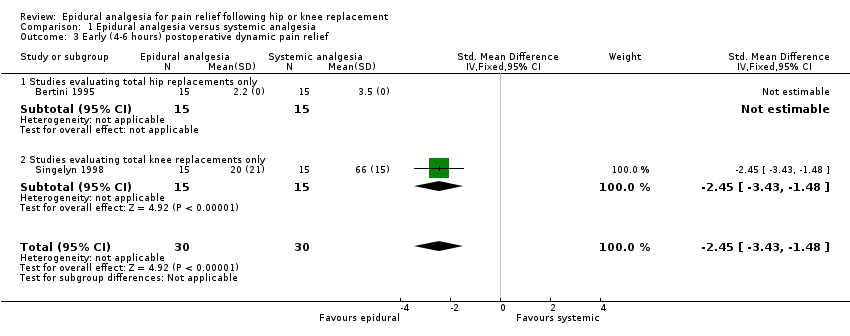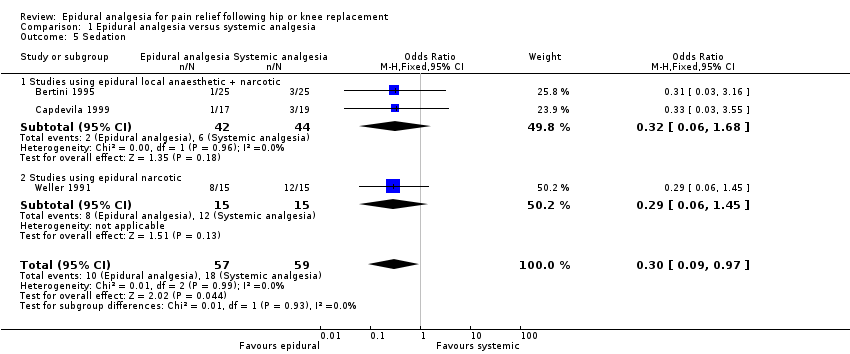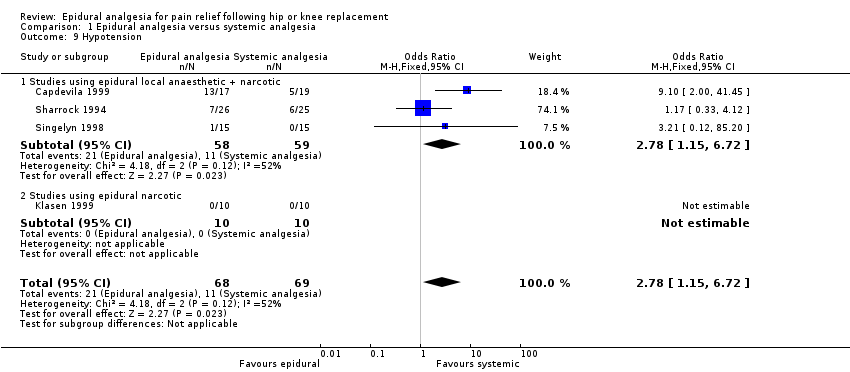| 1 Early (4‐6 hours) postoperative pain relief at rest Show forest plot | 7 | 236 | Std. Mean Difference (IV, Fixed, 95% CI) | ‐0.77 [‐1.24, ‐0.31] |
|
| 1.1 Studies evaluating total hip replacements only | 1 | 50 | Std. Mean Difference (IV, Fixed, 95% CI) | 0.0 [0.0, 0.0] |
| 1.2 Studies evaluating total knee replacement only | 4 | 122 | Std. Mean Difference (IV, Fixed, 95% CI) | ‐0.66 [‐1.30, ‐0.02] |
| 1.3 Studies evaluating total hip or total knee replacements | 2 | 64 | Std. Mean Difference (IV, Fixed, 95% CI) | ‐0.90 [‐1.57, ‐0.22] |
| 2 Late (18‐24 hours) postoperative pain relief at rest Show forest plot | 6 | 182 | Std. Mean Difference (IV, Fixed, 95% CI) | ‐0.29 [‐0.73, 0.16] |
|
| 2.1 Studies evaluating total hip replacements only | 1 | 50 | Std. Mean Difference (IV, Fixed, 95% CI) | 0.0 [0.0, 0.0] |
| 2.2 Studies evaluating total knee replacements only | 4 | 102 | Std. Mean Difference (IV, Fixed, 95% CI) | ‐0.47 [‐1.04, 0.10] |
| 2.3 Studies evaluating total hip or total knee replacements | 1 | 30 | Std. Mean Difference (IV, Fixed, 95% CI) | 0.0 [‐0.72, 0.72] |
| 3 Early (4‐6 hours) postoperative dynamic pain relief Show forest plot | 2 | 60 | Std. Mean Difference (IV, Fixed, 95% CI) | ‐2.45 [‐3.43, ‐1.48] |
|
| 3.1 Studies evaluating total hip replacements only | 1 | 30 | Std. Mean Difference (IV, Fixed, 95% CI) | 0.0 [0.0, 0.0] |
| 3.2 Studies evaluating total knee replacements only | 1 | 30 | Std. Mean Difference (IV, Fixed, 95% CI) | ‐2.45 [‐3.43, ‐1.48] |
| 4 Nausea or vomiting Show forest plot | 9 | 371 | Odds Ratio (M‐H, Fixed, 95% CI) | 0.95 [0.60, 1.49] |
|
| 4.1 Studies using epidural local anaesthetic + narcotic | 4 | 158 | Odds Ratio (M‐H, Fixed, 95% CI) | 0.88 [0.40, 1.94] |
| 4.2 Studies using epidural narcotic | 4 | 123 | Odds Ratio (M‐H, Fixed, 95% CI) | 2.10 [0.96, 4.59] |
| 4.3 Studies using epidural local anaesthetic | 1 | 90 | Odds Ratio (M‐H, Fixed, 95% CI) | 0.38 [0.16, 0.90] |
| 5 Sedation Show forest plot | 3 | 116 | Odds Ratio (M‐H, Fixed, 95% CI) | 0.30 [0.09, 0.97] |
|
| 5.1 Studies using epidural local anaesthetic + narcotic | 2 | 86 | Odds Ratio (M‐H, Fixed, 95% CI) | 0.32 [0.06, 1.68] |
| 5.2 Studies using epidural narcotic | 1 | 30 | Odds Ratio (M‐H, Fixed, 95% CI) | 0.29 [0.06, 1.45] |
| 6 Urinary retention Show forest plot | 5 | 166 | Odds Ratio (M‐H, Fixed, 95% CI) | 3.50 [1.63, 7.51] |
|
| 6.1 Studies using epidural local anaesthetic + narcotic | 2 | 66 | Odds Ratio (M‐H, Fixed, 95% CI) | 4.33 [0.71, 26.53] |
| 6.2 Studies using epidural narcotic | 3 | 100 | Odds Ratio (M‐H, Fixed, 95% CI) | 3.33 [1.43, 7.75] |
| 7 Pruritis Show forest plot | 6 | 209 | Odds Ratio (M‐H, Fixed, 95% CI) | 4.74 [1.76, 12.78] |
|
| 7.1 Studies using epidural local anaesthetic + narcotic | 2 | 86 | Odds Ratio (M‐H, Fixed, 95% CI) | 1.07 [0.17, 6.60] |
| 7.2 Studies using epidural narcotic | 4 | 123 | Odds Ratio (M‐H, Fixed, 95% CI) | 9.16 [2.45, 34.22] |
| 8 Respiratory depression Show forest plot | 5 | 204 | Odds Ratio (M‐H, Fixed, 95% CI) | 1.07 [0.45, 2.54] |
|
| 8.1 Studies using epidural local anaesthetic + narcotic | 2 | 101 | Odds Ratio (M‐H, Fixed, 95% CI) | 0.47 [0.15, 1.51] |
| 8.2 Studies using epidural narcotic | 3 | 103 | Odds Ratio (M‐H, Fixed, 95% CI) | 3.88 [0.78, 19.36] |
| 9 Hypotension Show forest plot | 4 | 137 | Odds Ratio (M‐H, Fixed, 95% CI) | 2.78 [1.15, 6.72] |
|
| 9.1 Studies using epidural local anaesthetic + narcotic | 3 | 117 | Odds Ratio (M‐H, Fixed, 95% CI) | 2.78 [1.15, 6.72] |
| 9.2 Studies using epidural narcotic | 1 | 20 | Odds Ratio (M‐H, Fixed, 95% CI) | 0.0 [0.0, 0.0] |










